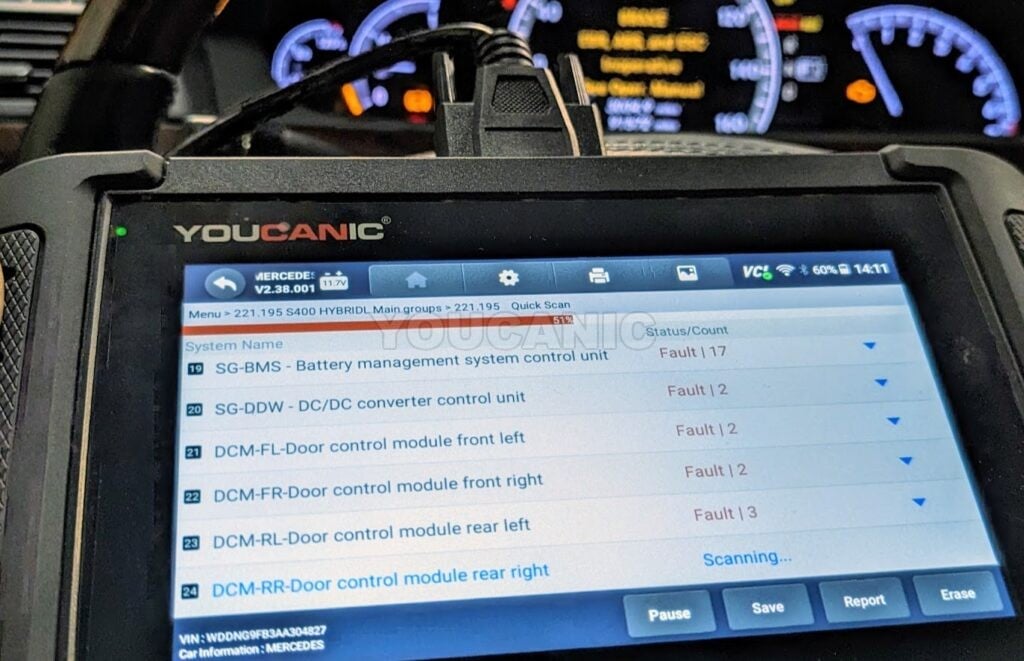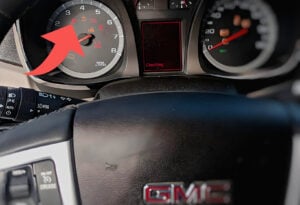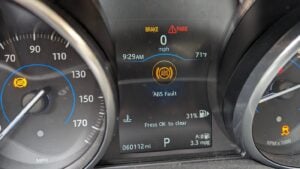Troubleshooting GMC ABS, Traction, Stability Control Lights On
The ABS light, traction control light, and stability control light on GMC vehicles come on when one of the ABS wheel speed sensors fails. In this article, we will look at common causes and how to use the YOUCANIC scanner to find out what is causing the ABS, traction, and stability control warning lights on your GMC vehicle.

What does the ABS light mean on a GMC?
The Anti-lock Braking System (ABS) on your GMC Sierra, Yukon, Savana, and other models prevents the brakes from locking up during sudden or emergency braking by regulating the hydraulic braking pressure. The ABS also uses various sensors, like the wheel speed sensor and the steering angle sensor, to detect the wheel speed and the direction of the vehicle’s turn. When the ABS light is on, it indicates a malfunction or fault within the entire anti-lock braking system. It is important to troubleshoot the problem immediately to ensure your vehicle’s safety and the ABS’s operability.
Symptoms
- ABS light stays on – ABS light is always on, in most cases due to a faulty ABS wheel speed sensor.
- ABS and TRC lights are on – Both ABS and TRC lights are on simultaneously, usually due to steering angle sensor issues.
- ABS and Brake light are on – Both ABS and Brake lights are simultaneously on which can be due to a faulty ABS pump.
- The vehicle requires a longer distance to stop – Due to the ABS is disabled, the brake system inoperative.
- Service traction control message – This message appears on the dashboard.
- Traction and stability get disabled – Both are disabled and not working.
Common Causes
There are many reasons why the ABS light turns on in your GMC. The wheel speed sensor is the most common cause and the cheapest part to replace. Solving a faulty speed sensor costs only $30 and usually takes about 30 minutes. Other common causes is the steering angle sensor needing calibration, faulty speed sensors, weak batteries, and many more.
Malfunctioning ABS Wheel Speed Sensor

The ABS wheel sped sensor is one of the most important parts of the anti-lock brake system. It detects the speed of each wheel to the ABS module to detect if any wheels are locking up by comparing which wheel is slower than the others.

If one or more wheel speed sensors are faulty, the ABS module detects and turns the ABS light on. There are many reasons why the ABS wheel speed sensor malfunction or becomes faulty. The sensor’s location on the wheel hub next to the wheels is prone to damage and dirt. One common cause is the build-up of dirt around the sensor. It prohibits the sensor from sensing the wheel speed and, thus, sending inaccurate data to the ABS module and triggering the ABS light on. Use the YOUCANIC scanner to determine which ABS wheel speed sensor is faulty.
Defective ABS Module

The ABS module is the brain of the entire anti-lock brake system. It is responsible for analyzing all the signals sent by all the sensors, and it also regulates the hydraulic pressure to prevent the brakes from locking up during sudden braking.
Different factors can result in an ABS module failure. Damage from water or heat and internal component failures are the common causes that can make the ABS module fail. This prevents the ABS module from performing its functions correctly, leading to the ABS light turning on. Common DTC present are C0265, C0201, U1041 Set and/or Loss of Communication with Brake Module and the common models affected:
- 1999-2007 GMC Sierra Classic
- 2000-2006 GMC Yukon, Yukon Denali, Yukon XL
- 2002-2007 GMC Envoy, Envoy XL, Sierra Denali Classic
- 2004-2005 GMC Envoy XUV
A malfunctioning ABS module can also engage at inappropriate times or even not engage during sudden braking. This can lead to accidents, and it is important to fix the problem immediately.
Faulty Steering Angle Sensor

The Anti-lock Brake System (ABS) and the Traction Control System use the steering angle sensor (SAS) to accurately detect the vehicle’s turn direction to regulate the braking pressure. A faulty SAS can send inaccurate signals to the ABS module, thus turning the ABS light on. The ABS and traction control warning light simultaneously lights up if the SAS is faulty.
Battery Needs Replacing

Like most other systems, the Anti-lock Braking System relies on the battery for a stable power supply to function properly. If the battery provides low power below 9.5 Volts, it is detected by the ABS module and triggers the ABS light. Low power can also make the sensors send inaccurate signals to the ABS module that can engage the brakes randomly or not function during emergency braking.
Damaged Wires or Connector

Wires and connectors are necessary to communicate between all parts of the Anti-lock Braking System. A damaged wire or connector can result in a loss of communication between the ABS module and sensors, thus turning on the ABS light.
Wires and connectors are also prone to damage and corrosion because it is exposed to harsh elements and road conditions under the vehicle. Various reasons usually cause a broken wire, tires rubbing onto it, and animals like rodents chewing on the wires. Connectors usually corrode over time and can cause a weak connection that makes the signal sent by the sensors inaccurate.
Blown Fuse

The ABS fuse protects the Anti-lock Braking System from sudden surges of power. The sudden power surge usually comes from a short circuit within the system. When a fuse is blown, it cuts the power from the battery to the entire ABS, leading to the ABS not working and turning the ABS light on. It is important to know the cause of the blown fuse before replacing it to avoid blowing the new fuse.
Insufficient Brake Fluid

The ABS uses brake fluid to regulate hydraulic pressure to prevent brakes from locking up. Maintaining the proper amount of brake fluid for the ABS to function correctly is necessary. A low brake fluid level can make the ABS not engage properly and turn the ABS light on. It also allows air to enter the brake lines, making the brakes spongy and unresponsive.
Brake fluid decreases because brake pads wear out and there is a leak within the system. It is important to determine the cause of the problem to resolve the issue properly. Topping up the brake fluid level can resolve the ABS light.
Troubleshooting & Reset Procedure

Use the YOUCANIC scanner to read the codes from the ABS control unit. The problem can be a faulty ABS wheel speed sensor, the scanner will point to the faulty wheel so that you know exactly which wheel speed sensor needs to be replaced.
- Locate the OBD II port under the dash of your vehicle. It is usually located near the driver’s side and is a 16-pin connector.
- Plug in the scanner and turn on the ignition, but do not start the engine.
- Select the make of your vehicle from the list of available makes. You can select “Auto Detect VIN” to automatically detect your vehicle’s make and model.
- Select “Control Units,” then “ABS/Traction Control Module.” Remember that the name of this module may vary depending on the make and model of your vehicle.
- Once the scanner is on, select “Diagnostics” from the main menu.
- Once you have selected the ABS/Traction Control Module, you can select “Read Codes” to see any stored trouble codes related to the ABS. The scanner will display the current codes, which will help you determine what may be causing the ABS and traction control warnings to turn on.
- Based on the codes, the scanner may suggest performing further tests or inspecting certain components of the ABS, such as the wheel speed sensors, brake lines, and hydraulic control unit.
- Once the underlying issue has been fixed, then select Clear Codes to clear fault codes stored in the ABS control unit and reset ABS and traction control warning lights.
Frequently Asked Questions
Can I drive my GMC vehicle if the ABS warning light is on?
It is not recommended to drive your GMC vehicle if the ABS warning light is on. The ABS is designed to help you maintain control of your vehicle during braking, especially on slippery surfaces. If the ABS light is on, it means there is a problem with the ABS that could make it more difficult to stop your vehicle.
If you must drive your GMC vehicle with the ABS light on, drive slowly and carefully. Avoid braking suddenly or forcefully. If you experience any difficulty stopping your vehicle, pull over to a safe location. Resolve the issue immediately to make the vehicle’s ABS function properly.
Can extreme temperatures cause my GMC Sierra 1500 ABS light to come on?
Yes, extreme temperatures can sometimes cause the ABS light to illuminate in GMC Sierra vehicles. Cold weather can cause the brake fluid to thicken, triggering the ABS light. Sometimes, the light may turn off once the vehicle warms up again.
How long do ABS typically last in GMC vehicles?
The lifespan of an ABS in a GMC vehicle can vary depending on factors such as the model and year of the vehicle, driving conditions, and maintenance history. It is recommended to have the system inspected regularly as part of the maintenance schedule to ensure proper functioning.
How can I prevent ABS issues in my GMC vehicle?
To help prevent ABS issues in your GMC vehicle, following the recommended maintenance schedule, regularly checking the brake fluid level, and driving safely and responsibly to minimize hard braking and skidding are important.
Fault Codes
- C0035 – Left Front Wheel Speed Sensor Circuit
- C0040 – Right Front Wheel Speed Sensor Circuit
- C0045 – Left Rear Wheel Speed Sensor Circuit
- C0050 – Right Rear Wheel Speed Sensor Circuit
- C0060 – Left Front ABS Solenoid Circuit
- C0065 – Right Front ABS Solenoid Circuit
- C0070 – Left Rear ABS Solenoid Circuit
- C0075 – Right Rear ABS Solenoid Circuit
- C0110 – Pump Motor Circuit
- C0131 – ABS/TCS System Pressure Circuit
- C0136 – ABS/TCS System Pressure Circuit Low
- C0137 – ABS/TCS System Pressure Circuit High
- C0186 – Lateral Accelerometer Circuit
- C0292 – Brake Apply Sensor Circuit Low
- C0298 – Brake Apply Sensor Circuit High






